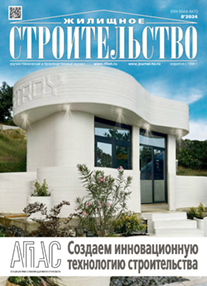Additive construction production: past, present, future
- Авторлар: Adamtsevich L.A.1, Pustovgar A.P.1,2, Adamtsevich A.O.1
-
Мекемелер:
- National Research Moscow State University of Civil Engineering
- Mechanical Engineering Research Institute named after A.A. Blagonravov of the Russian Academy of Sciences
- Шығарылым: № 8 (2024)
- Беттер: 3-10
- Бөлім: Articles
- URL: https://ter-arkhiv.ru/0044-4472/article/view/642635
- DOI: https://doi.org/10.31659/0044-4472-2024-8-3-10
- ID: 642635
Дәйексөз келтіру
Аннотация
An overview of the development of additive construction production from the beginning of the formation of prerequisites to the present moment and future prospects for the development of 3D construction printing in the world is given.The publications of international citation databases, including the results of research in the field of additive construction production for the period from 1972 to 2024, are considered as the basis of the study.The study is divided into several stages, the first of which is devoted to the analysis of search queries and the definition of relevant keywords.It was revealed that the most popular phrases describing the use of additive technologies in construction are “Concrete Printing” and “3D Concrete Printing”, therefore, as part of the subsequent stage of work, abstract samples were formed on their basis to analyze and summarize the results of relevant scientific research. The final stage of the study included a more detailed study of the main results of scientific works characteristic of three time intervals describing past, present and future trends in scientific activity in the subject area under consideration. The results of the study show a significant increase in interest in the technology of construction 3D printing with concrete due to the realization of the potential to increase labor productivity in construction and reduce the negative impact on the environment in comparison with traditional construction production technologies, which can become a driver of sustainable development of the construction industry.The conducted research makes it possible to conclude that there are still unresolved problems on the way of active implementation of the technology, which are constraining factors for the widespread introduction of additive construction production, in particular the issues of printing horizontal structures of floors and coatings of buildings, reinforcement of load-bearing structures printed with a 3D printer. According to the authors, the solution of these problems should be given priority in future research, along with the development of new formulations for 3D printing with concrete.
Толық мәтін
Авторлар туралы
L. Adamtsevich
National Research Moscow State University of Civil Engineering
Хат алмасуға жауапты Автор.
Email: AdamtsevichLA@mgsu.ru
Candidate of Sciences (Engineering) (AdamtsevichLA@mgsu.ru)
Ресей, 26, Yaroslavskoe Highway, Moscow, 129337A. Pustovgar
National Research Moscow State University of Civil Engineering; Mechanical Engineering Research Institute named after A.A. Blagonravov of the Russian Academy of Sciences
Email: PustovgarAP@mgsu.ru
Candidate of Sciences (Engineering)
Ресей, 26, Yaroslavskoe Highway, Moscow, 129337; 4, Malyy Kharitonyevskiy Per., Moscow, 101000A. Adamtsevich
National Research Moscow State University of Civil Engineering
Email: AdamtsevichAO@mgsu.ru
Candidate of Sciences (Engineering)
Ресей, 26, Yaroslavskoe Highway, Moscow, 129337Әдебиет тізімі
- Adamtsevich A.O., Pustovgar A.P., Adamtsevich L.A. Additive construction production: review of world experience. Promyshlennoye i grazhdanskoye stroitel’stvo. 2023. No. 12, pp. 83–97. (In Russian). https://doi.org/10.33622/0869-7019.2023.12.83-97
- Adamtsevich A.O., Pustovgar A.P. Additive manufacturing in construction: the research of the anisotropy concrete strength effect. Stroitel’nye Materialy [Construction Materials]. 2022. No. 9, pp. 18–24. (In Russian). https://doi.org/10.31659/0585-430X-2022-806-9-18-24
- Pustovgar A.P., Adamtsevich L.A., Adamtsevich A.O. International research experience in the field of additive construction production. Zhilishchnoe Stroitel’stvo [Housing Constructions]. 2023. No. 11, pp. 4–10. https://doi.org/10.31659/0044-4472-2023-11-4-10
- Le T., Austin S., Lim S., Gibb, A., Thorpe T. High-performance printing concrete for freeform building components. fib Symposium PRAGUE 2011: Concrete Engineering for Excellence and Efficiency, Proceedings. 2011. 1, pp. 499–502.
- Rushing T.S., Al-Chaar G., Eick B.A., Burroughs J., Shannon J., Barna L., Case M. Investigation of concrete mixtures for additive construction. Rapid Prototyping Journal. 2017. Vol. 23, pp. 74–80. https://doi.org/10.1108/RPJ-09-2015-0124
- Lao W., Li M., Tjahjowidodo T. Variable-geometry nozzle for surface quality enhancement in 3D concrete printing. Additive Manufacturing. 2021. Vol. 37. https://doi.org/10.1016/j.addma.2020.101638
- Alyami M., Khan M. et all. Predictive modeling for compressive strength of 3D printed fiber-reinforced concrete using machine learning algorithms. Case Studies in Construction Materials. 2024. Vol. 20. https://doi.org/10.1016/j.cscm.2023.e02728
- Şahin H.G., Mardani A. How does rheological behaviour affect the interlayer-bonding strength of 3DPC mixtures? Journal of Adhesion Science and Technology. 2024. Vol. 38, pp. 1353–1377. https://doi.org/10.1080/01694243.2023.2266211
- Xiao J., Bai M., Wu Y., Duan Z., Qin J. Interlayer bonding strength and pore characteristics of 3D printed engineered cementitious composites (ECC). Journal of Building Engineering. 2024. Vol. 84. https://doi.org/10.1016/j.jobe.2024.108559
- Wang X., Li W., Guo Y., Kashani A., Wang K., Ferrara L., Agudelo I. Concrete 3D printing technology for sustainable construction: A review on raw material, concrete type and performance. Developments in the Built Environment. 2024. Vol. 17. https://doi.org/10.1016/j.dibe.2024.100378
Қосымша файлдар



















